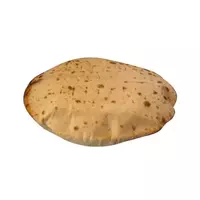Chapati

Traditional Indian cuisine recipes surprise with their diversity. In addition, not every culinary tradition has as many aromas, flavors and colors as are observed in the dishes of this cuisine. This fact is largely due to the use of a large number of spices in cooking.
In addition, there are a number of recipes that use a really minimal number of components, although the result is always excellent. For example, chapati are thin roti tortillas, which are traditional fresh bread for India, which is made from flour mainly coarse grinding.
Chapati tortillas, like their close relatives roti tortillas, are an integral part of both Indian and Pakistani traditional cuisines. Chapati tortillas are also made from wheat flour, and even in appearance they resemble thin pita bread. First, chapati is cooked in a dry frying pan and then baked over an open heat. With thermal treatment, chapati cakes begin to swell rapidly from a couple to such an extent that they acquire a round shape like a ball. It is customary to consume chapati as bread, but at the same time tearing pieces from the tortilla and dipping them into various sauces.
The name chapati itself supposedly originates from the Turkic word "shappoty, " which translates as "palm kick. " Most likely, this type of fresh bread came to India during the time of Babur, but today such tortillas are often found in certain parts of the Ferghana Valley. In northern India, chapati with fillers are most common, among which the most popular is mashed potatoes with fried onions.
Chapati can be purchased in specialized bread shops, but making these tortillas at home is not so difficult. To do this, you need to mix the flour with salt in a large bowl, after which, gradually adding water (vegetable oil in some recipes), knead the soft dough. Then the fresh dough is transferred to a flat surface and kneaded until homogeneous. Drizzled with water, the dough is covered with a damp cloth and left for a while (no more than 2 hours).
After that, a cast-iron frying pan is heated, the dough is covered with wet hands and balls of the same size are formed, which are dipped in flour and finely rolled. The tortillas are toasted in a dry pan with constant turning, when bubbles begin to form on the surface of the chapati. It remains only to take the tortillas and bring them to the fire, as they almost immediately (in a few seconds) swell like balls. Ready-made chapati must be slammed with your hands to release all the air, and lubricated on one side with melted oil.
chapati 370 kCal
Energy value of chapati (Ratio of proteins, fats, carbohydrates - ju):
Proteins: 75.16 (~ 301 kCal)
Fats: 1.85 g. (~ 17 kCal)
Carbohydrates: 13.79 g (~ 55 kCal)
Energy ratio (bj | y): 81% | 5% | 15%
 Español
Español Français
Français Português
Português Русский
Русский 简体中文
简体中文 繁體中文
繁體中文 日本語
日本語 한국어
한국어 العربية
العربية Türkçe
Türkçe Қазақ
Қазақ Deutsch
Deutsch Italiano
Italiano Українська
Українська
